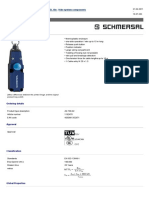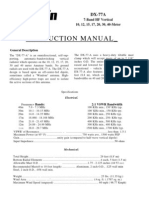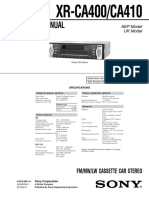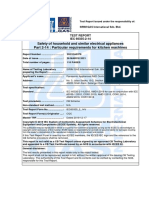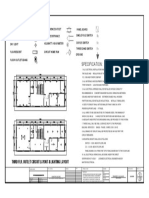Model PEXP Pulse Transmitter Installation:Maintenance:Service
Model PEXP Pulse Transmitter Installation:Maintenance:Service
Uploaded by
Bahaa HasanCopyright:
Available Formats
Model PEXP Pulse Transmitter Installation:Maintenance:Service
Model PEXP Pulse Transmitter Installation:Maintenance:Service
Uploaded by
Bahaa HasanCopyright
Available Formats
Share this document
Did you find this document useful?
Is this content inappropriate?
Copyright:
Available Formats
Model PEXP Pulse Transmitter Installation:Maintenance:Service
Model PEXP Pulse Transmitter Installation:Maintenance:Service
Uploaded by
Bahaa HasanCopyright:
Available Formats
Smith Meter® Transmitters
Model PEXP
Pulse Transmitter
Installation/Maintenance/Service
Issue/Rev. 0.3 (10/99) Bulletin MN01020
Mechanical Installation
The PEXP Transmitter should be installed at the lowest
level in the meter accessory stack. This will minimize the
amount of vibration and provide the longest and most
reliable service.
Be sure drive couplings are properly engaged and that
weatherproof gaskets are installed before tightening
mounting screws.
Dimensions - Inches (mm)
Figure 2 – PEXP in Accessory Stack
Table 1
Distance* Wire/Size
Up to 2,000 ft. (610 meters) #20
Multiple conductor
4 Holes Up to 3,000 ft. (915 meters) #18 insulated, 100%
3/8" – 16 UNC shielded cable
Spaced @ 90° on Up to 5,000 ft. (1,525 meters) #16
5.0" (127) *For distances greater than listed above, contact factory and advise:
Diameter Bolt Circle
·Type of instrument and if capacitive coupled.
·Output frequency at maximum flow rate - pulses/second (Hz).
·Transmission length.
Shield
Blue PPR Switch
Blue
(use optional)
Fork Drive Black
Signal
Whire
Signal return
Red
+Vdc
Figure 1
Green
Safety Ground
Electrical Installation
Figure 3
A 1/2" female NPT conduit thread entry is provided on Important: Cut shield back to insulation and tape.
the housing the entry will have a thread protector that Terminate shield at receiving instrument.
must be removed. A minimum of 12 inches of flexible Double check all field wire connections before operation.
conduit and a conduit union fitting should be used to Incorrect wiring may damage or destroy the circuitry in
join the housing to rigid conduit. This will facilitate later the PEXP Transmitter.
removal and replacement of he PEXP Transmitter.
*See specification Bulletin SS01051L for further information
Power Supply Requirements*
Positive 10 Vdc @ 48 mA maximum to positive 26 Vdc
@ 86 mA maximum. To help assure this voltage is
available at the transmitter, the wires sizes in Table 1
should be used:
The Most Trusted Name In Measurement
Mechanical Maintenance Procedure:
1. Remove the four cover screws and tap the cover
Temperature Range gently to break the seal.
-40°F to 158 °F (-40°C to 70°C) 2. Carefully loosen the cover to the length of the align-
All bearings in the PEXP Transmitter are self-lubricating ment pins (0.75 in.).
and should require no servicing. However, there are two 3. Swing the right side of the cover away from the PEXP
gears which should be lubricated annually and adjusted body until the reed switch clears the body cast-
if necessary. ing, while holding the left side of the cover in place.
4. Gently remove the cover.
Caution 5. Notice that the five (5) wire connector is probably
Extreme caution must be used when removing the already disconnected. (Connector lead is short and
cover of the PEXP to prevent damage to the reed probably pulled off as the cover was removed.)
switch that is located inside the cover plate. Fol- 6. Check gear teeth for wear or excessive backlash.
low the procedure described below while referring Also check that the drive gear set screw is securely
to Figure 4. tightened in order to drive the shaft.
7. Adjust backlash by loosening the two screws which
hold the locking plate. Turn disc post counterclock-
wise (eccentricity between disc post and disc shaft
allow gear centers to be varied).
Note: There are two positions which can provide
proper backlash - the correct position is obtained by
rotating the post counterclockwise.
While rotating the drive fork, adjust disc post until
Reed Switch gears begin to jam. Back off (clockwise) until gears
(See Caution) just run smooth. Tighten locking plate and test again.
Repeat until gears run smoothly with locking plate
tightened.
8. Apply specified grease sparingly to gear teeth. Do
not allow grease to be smeared on slotted disc.
9. Apply a light coating of specified grease to the cover
Cover before replacing. This provides a water-tight seal.
10. Connect the five (5) wire connector to the circuit
board, locate cover guide pins and slide cover into
Figure 4 place. Replace the four (4) screws and the seal wire.
Material required:
Grease – Anderol L-795
Aeroshell 14 or
Esso Beacon 325
Allen wrench (long) – 1/16”
Screwdrivers – 1/2" blade and 1/8" blade
Page 2 • MN01020 Issue/Rev. 0.3 (10/99)
Electrical Maintenance wire (black) of the transmitter. Rotate the PEXP at nor-
mal speed and note the voltage. The graph (Figure 5)
The electrical circuitry is designed to provide reliable can now be used to determine the duty cycle. The duty
service with a minimum of attention. Because electrical cycle should fall at the optimum (47-53%) point and must
components change value during the aging process, it fall between the maximum and minimum points.
may become necessary to adjust the symmetry of the Caution
square wave output signal.
Extreme caution must be used when removing the
This can be done as follows: cover of the PEXP to prevent damage to the reed
Materials required: switch that is located inside the cover plate. Follow
Grease – Anderol L-795 the procedure described below while referring to
Aeroshell 14 or Figure 4.
Esso Beacon 325 1. Remove the four cover screws and tap the cover
Screwdrivers – 1/2" blade and 1/8" blade gently to break the seal.
Voltmeter – Analog type (Simson 260 VOM or equiva- 2. Carefully loosen the cover to the length of the align-
lent) or Digital (Fluke 8020 or equivalent) ment pins (0.75 in.).
Procedure: 3. Swing the right side of the cover away from the PEXP
This adjustment can be made with the PEXP Transmit- body until the reed switch clears the body casting,
ter in the meter accessory stack. However, a means of while holding the left side of the cover in place.
providing rotation (flow) will be necessary. In order to 4. Gently remove the cover.
make the symmetry adjustment, it will be necessary to 5. Locate the trim potentiometer on the printed circuit
measure the input voltage and use the graph (Figure 5) board and adjust trim pot (1/4 turn clockwise yields
to arrive at the proper adjustment. 20% increase of "on time").
Note: The following voltage must be measured with the 6. Replace the cover by reversing Steps 1-4 above.
black signal wire disconnected.
7. Tighten the cover screws and check voltage.
Connect the positive lead of the voltmeter to the trans-
mitter's +Vdc wire (red) and the negative lead to com- 8. Be sure the cover flange has a light covering of grease
mon (white). The voltage must be between 9 Vdc and to ensure water tightness.
26 Vdc. If it is not, then the power supply voltage must 9. Repeat the adjustment until a duty cycle voltage within
be corrected. Once this voltage has been determined, the 40/60 - 60/40 range is obtained, preferably at the
connect the positive lead of the voltmeter to the signal optimum value.
PEXP Output Voltage vs Power Supply
12
RMS Signal Output Voltage
10
0
10 12 14 16 18 20 22 24
Power Supply Voltage
40% On / 60% Off 50% On / 50% Off 60% On / 40% Off
Figure 5 – Duty Cycle
Issue/Rev. 0.3 (10/99) MN01020 • Page 3
Repair 2. Remove drive gear by driving pin from top drive cou-
pling, loosen the set screw in the drive gear, and draw
Should the PEXP Transmitter gears show excessive the drive shaft from the bottom of the unit.
wear or the circuit board fails to function, they will require 3. Replace the drive gear and the slotted disc and re-
replacement. This is done as follows: assemble. The drive gear should be adjusted on the
Material required: drive shaft so that its bottom edge is flush with the
bottom edge of the slotted disc gear.
Grease – Anderol L-795
Aeroshell 14 or See Mechanical Maintenance Section for backlash
Esso Beacon 325 adjustment, lubrication, and final assembly procedures.
Allen wrench (long) – 1/16” Circuit Board
Screwdrivers – 1/2" blade and 1/8" blade The replacement of the printed circuit board requires
1/16" Punch and small hammer a symmetry adjustment. See Electrical Maintenance
procedure.
Gears
See Mechanical Maintenance Section for cover removal
procedure. Then:
1. Remove slotted disc by removing "E" ring at the top
of the disc shaft and removing clamping plate to allow
disc post to be drawn from the bottom of the unit.
Revisions included in MN01020 Issue/Rev. 0.3 (10/99):
Page 1: Editorial Change - changed reference from SS01051 to SS01051L.
Page 2: Revised Figure 5 - Duty Cycle
The specifications contained herein are subject to change without notice and any user of said specifications should verify from the manufacturer that the specifications are currently
in effect. Otherwise, the manufacturer assumes no responsibility for the use of specifications which may have been changed and are no longer in effect.
Contact information is subject to change. For the most current contact information, visit our website at www.fmctechnologies.com/measurementsolutions and click on the
“Contact Us” link in the left-hand column.
Headquarters:
500 North Sam Houston Parkway West, Suite 100, Houston, TX 77067 USA, Phone: +1 (281) 260 2190, Fax: +1 (281) 260 2191
Measurement Products and Equipment: Integrated Measurement Systems:
Erie, PA USA +1 (814) 898 5000 Dubai, United Arab Emirates +971 (4) 883 0303 Corpus Christi, TX USA +1 (361) 289 3400
Ellerbek, Germany +49 (4101) 3040 Los Angeles, CA USA +1 (310) 328 1236 Kongsberg, Norway +47 (32) 286700
Barcelona, Spain +34 (93) 201 0989 Melbourne, Australia +61 (3) 9807 2818 Dubai, United Arab Emirates +971 (4) 883 0303
Beijing, China +86 (10) 6500 2251 Moscow, Russia +7 (495) 5648705
Burnham, England +44 (1628) 603205 Singapore, +65 6861 3011
Visit our website at www.fmctechnologies.com/measurementsolutions
Printed in U.S.A. © 8/90 FMC Technologies Measurement Solutions, Inc. All rights reserved. MN01020 Issue/Rev. 0.3 (10/99)
You might also like
- Eco-Drain 32 Manual en 01-2405-v01Document36 pagesEco-Drain 32 Manual en 01-2405-v01adyro1260% (5)
- 244 HyGain Quad AntennaDocument21 pages244 HyGain Quad AntennaJorge AguilarNo ratings yet
- HP c15.2 DynacordDocument6 pagesHP c15.2 DynacordenisdjiouNo ratings yet
- HP C12.2 DynacordDocument6 pagesHP C12.2 DynacordenisdjiouNo ratings yet
- Rev F - 7671 Atex Pulser Install ManDocument4 pagesRev F - 7671 Atex Pulser Install ManYoussef AdnaneNo ratings yet
- Furuno MD 550 Service ManualDocument12 pagesFuruno MD 550 Service ManualANDREASBOUL100% (1)
- 9K688NDocument7 pages9K688NHelar Armejo VasquezNo ratings yet
- BQ5477Document10 pagesBQ5477Helar Armejo VasquezNo ratings yet
- Color Television/ Video Cassette Recorder: Service ManualDocument61 pagesColor Television/ Video Cassette Recorder: Service Manualomaderas1No ratings yet
- MD550 Operator's Manual B 1-11-07Document12 pagesMD550 Operator's Manual B 1-11-07Eric PskdNo ratings yet
- MEMOREX mt1194Document30 pagesMEMOREX mt1194Saul ArriagaNo ratings yet
- Color Television: Service ManualDocument38 pagesColor Television: Service ManualFreddy MorilloNo ratings yet
- Color Television: Service ManualDocument38 pagesColor Television: Service ManualEsdras MonroyNo ratings yet
- Sc-T1ja eDocument2 pagesSc-T1ja eAjay MayalNo ratings yet
- 3-3 Ome44080b 2 MD550Document12 pages3-3 Ome44080b 2 MD5501121986jedNo ratings yet
- Color Television: Service ManualDocument38 pagesColor Television: Service Manualelita04No ratings yet
- Step Attenuator DIYDocument3 pagesStep Attenuator DIYfred osterNo ratings yet
- Toshiba Orion 20as22 - SvcmanDocument32 pagesToshiba Orion 20as22 - SvcmanDeyby GarciaNo ratings yet
- Fk-202F Transducer: SpecificationsDocument2 pagesFk-202F Transducer: Specifications莊淯淞No ratings yet
- Color Television: Service ManualDocument35 pagesColor Television: Service Manualmohamed tawfikNo ratings yet
- RCA 14M041 Service ManualDocument34 pagesRCA 14M041 Service ManualferdialvascribdNo ratings yet
- th6 DXXDocument22 pagesth6 DXXNenad PetrovicNo ratings yet
- Duke Esi/Rm (X) Installation and Operation Manual Duke Part No. 10192 Rev. BDocument8 pagesDuke Esi/Rm (X) Installation and Operation Manual Duke Part No. 10192 Rev. BCarlos Salazar ZeladaNo ratings yet
- Datasheet - ZQ 700-02: Print Create PDF Create EXCEL File Hide System ComponentsDocument8 pagesDatasheet - ZQ 700-02: Print Create PDF Create EXCEL File Hide System ComponentsCris OliveiraNo ratings yet
- Hyg Dx77a ManualDocument14 pagesHyg Dx77a Manualve7eoeNo ratings yet
- HVT Series Terminations 15-35kV Class High Voltage Termination For LC Shield CableDocument6 pagesHVT Series Terminations 15-35kV Class High Voltage Termination For LC Shield Cable20353124No ratings yet
- Water Flow Switch VSR-SDocument11 pagesWater Flow Switch VSR-ScospafoydoNo ratings yet
- Component Speakers: S4.525C S4.65CDocument8 pagesComponent Speakers: S4.525C S4.65CcamposmiltonNo ratings yet
- A05 1032 PDFDocument2 pagesA05 1032 PDFArgile-assholeNo ratings yet
- EFT10-20-40 Trail VPDocument5 pagesEFT10-20-40 Trail VPKevin WalmsleyNo ratings yet
- Raychem Mod-HvtDocument12 pagesRaychem Mod-Hvtcarlostobar109No ratings yet
- Model FS-2 Paddle Flow Switch: Specifications - Installation and Operating InstructionsDocument2 pagesModel FS-2 Paddle Flow Switch: Specifications - Installation and Operating InstructionsMinh Nhut LuuNo ratings yet
- Instalacion Anunciador FS-RD2-RDocument4 pagesInstalacion Anunciador FS-RD2-ReolorojasNo ratings yet
- Service Manual: Color Television ReceiverDocument35 pagesService Manual: Color Television ReceiverCinddy GarciaNo ratings yet
- Akai CFT2726Document27 pagesAkai CFT2726OnTech ForceNo ratings yet
- Sony Xr-Ca400 Ca410Document34 pagesSony Xr-Ca400 Ca410Abdelkader SergeNo ratings yet
- Yf 200Document25 pagesYf 200dottodotNo ratings yet
- PreampDocument5 pagesPreampkhaldonalwafi0No ratings yet
- WFDTH Waterflow Detector: Sprinkler Systems MonitoringDocument2 pagesWFDTH Waterflow Detector: Sprinkler Systems MonitoringArgile-assholeNo ratings yet
- ElectroVoice 903E Rev. 09Document4 pagesElectroVoice 903E Rev. 09madecary145No ratings yet
- Sharp xl-s10Document44 pagesSharp xl-s10luuk.wNo ratings yet
- BE46 648 2 - JupiterDocument36 pagesBE46 648 2 - Jupitercraig.bakerNo ratings yet
- Adjustable Proximity Sensor: Model H3C-HDocument6 pagesAdjustable Proximity Sensor: Model H3C-HΗρακλης ΤσαπραζηςNo ratings yet
- Th-3Jrs Instruction ManualDocument11 pagesTh-3Jrs Instruction ManualLuis CuberoNo ratings yet
- Panzerflex L 2Document2 pagesPanzerflex L 2Nino BallatanNo ratings yet
- 888 83 059 G OrigDocument9 pages888 83 059 G OrigCarlos J. Buznego NiochetNo ratings yet
- NT6 Instruction ManualDocument12 pagesNT6 Instruction ManualOscar JiménezNo ratings yet
- SD314 HF1P4SNM (D00) DiDocument2 pagesSD314 HF1P4SNM (D00) DiJuan Guillermo Palacio UribeNo ratings yet
- E85010-0111 - Battery Distribution UnitDocument2 pagesE85010-0111 - Battery Distribution UnitjsaromatocNo ratings yet
- Decibel FilterDocument2 pagesDecibel Filterbinhmaixuan100% (1)
- Sharp Lc-32av22u LCD TV SMDocument100 pagesSharp Lc-32av22u LCD TV SMAnna SantosNo ratings yet
- ServiceManual CTV2131PFDVDDocument44 pagesServiceManual CTV2131PFDVDcroefus9525100% (1)
- Color Television: Service ManualDocument37 pagesColor Television: Service ManualJhorman SanchezNo ratings yet
- Memorex Mt1136a Micro-Oec3039bDocument28 pagesMemorex Mt1136a Micro-Oec3039bantony vargas100% (1)
- Toshiba 13A24Document32 pagesToshiba 13A24jesusNo ratings yet
- Radio Shack TRS-80 Expansion Interface: Operator's Manual Catalog Numbers: 26-1140, 26-1141, 26-1142From EverandRadio Shack TRS-80 Expansion Interface: Operator's Manual Catalog Numbers: 26-1140, 26-1141, 26-1142No ratings yet
- Analog Dialogue Volume 46, Number 1: Analog Dialogue, #5From EverandAnalog Dialogue Volume 46, Number 1: Analog Dialogue, #5Rating: 5 out of 5 stars5/5 (1)
- Reference Guide To Useful Electronic Circuits And Circuit Design Techniques - Part 2From EverandReference Guide To Useful Electronic Circuits And Circuit Design Techniques - Part 2No ratings yet
- Delco Manuals: Radio Model 633, Delcotron Generator Delco Radio Owner's Manual Model 633, Delcotron Generator InstallationFrom EverandDelco Manuals: Radio Model 633, Delcotron Generator Delco Radio Owner's Manual Model 633, Delcotron Generator InstallationNo ratings yet
- EIM 10 Quarter 4 - Module 6 Nstalling Wiring Devices For Floor and Ground Fault Current Interrupting OutletDocument6 pagesEIM 10 Quarter 4 - Module 6 Nstalling Wiring Devices For Floor and Ground Fault Current Interrupting OutletEDU CHIONGNo ratings yet
- 410009f TR Electrical InstallationDocument31 pages410009f TR Electrical InstallationMaría MartinezNo ratings yet
- ML7420A-7425AB SD ENDocument4 pagesML7420A-7425AB SD ENSameer JainNo ratings yet
- Tips On Shielding and Grounding in Industrial Automation - Technical Article PDFDocument20 pagesTips On Shielding and Grounding in Industrial Automation - Technical Article PDFTim BirloivNo ratings yet
- PM1360 Controls (Wiring)Document20 pagesPM1360 Controls (Wiring)FaresNo ratings yet
- VRV III Daikin CatalogueDocument82 pagesVRV III Daikin CatalogueJohan A. Psaila0% (1)
- 1) 1C LSZHDocument44 pages1) 1C LSZHvicko2828No ratings yet
- Cable Sizing Calculation - Open ElectricalDocument9 pagesCable Sizing Calculation - Open ElectricalTaz UddinNo ratings yet
- LG bs254 bx254 bx324 PDFDocument86 pagesLG bs254 bx254 bx324 PDFinfologicalNo ratings yet
- KE01-00-000-KD-A-LD-0002-000 - P03 Supplier Doc DescriptionDocument34 pagesKE01-00-000-KD-A-LD-0002-000 - P03 Supplier Doc DescriptionMaffone Numerouno100% (2)
- UPower Hi Manual EN V2.2Document60 pagesUPower Hi Manual EN V2.2merahNo ratings yet
- 1-100 Chapter 3 ReviewerDocument5 pages1-100 Chapter 3 ReviewerBlessie Joy DalinaNo ratings yet
- SDH Operation Manual V1 02Document220 pagesSDH Operation Manual V1 02vi phanNo ratings yet
- EW2002 AP 0610 Web - SVI2Ap With Remote SensorDocument160 pagesEW2002 AP 0610 Web - SVI2Ap With Remote SensorTito IndrajantoNo ratings yet
- Honeywell NEMA Type 4 EnclosureDocument202 pagesHoneywell NEMA Type 4 EnclosurebioNo ratings yet
- Cable Gland Selection - Hawke PDFDocument82 pagesCable Gland Selection - Hawke PDFvlabdulazeem100% (1)
- Webasto UniControl Installation InstructionsDocument13 pagesWebasto UniControl Installation InstructionsFabrizio CingolaniNo ratings yet
- Compresor PDFDocument108 pagesCompresor PDFJorge Garcia100% (2)
- Installation Instructions Installing Ground DisksDocument36 pagesInstallation Instructions Installing Ground DisksVIJAY KUMAR SAJJANo ratings yet
- Bihar State Tourism Development CorporationDocument54 pagesBihar State Tourism Development CorporationKishore A JhaNo ratings yet
- Noise Control in Strain Gage Measurements: Strain Gages and InstrumentsDocument8 pagesNoise Control in Strain Gage Measurements: Strain Gages and Instrumentsnsk143446No ratings yet
- Technical Specification Compliance HT - 1 Panel - 24072020 - Smart Electric (ABB)Document48 pagesTechnical Specification Compliance HT - 1 Panel - 24072020 - Smart Electric (ABB)Muthu KumaranNo ratings yet
- Electrical BOQ150710Document11 pagesElectrical BOQ150710Jaime Manalili LandinginNo ratings yet
- CB Test ReportDocument125 pagesCB Test ReportmadeNo ratings yet
- DDSU666 Single Phase Electronic Energy Meter User Manual: 1.overview of ProductsDocument2 pagesDDSU666 Single Phase Electronic Energy Meter User Manual: 1.overview of ProductsMarcos Gomes100% (1)
- 3rd FloorDocument1 page3rd FloorJopheth RelucioNo ratings yet
- W211 APS50 Retrofit 2 PDFDocument2 pagesW211 APS50 Retrofit 2 PDFTiago SantosNo ratings yet
- IEE Harmonized ColoursDocument4 pagesIEE Harmonized ColourstatacpsNo ratings yet
- Section 714 Oudoor LightingDocument2 pagesSection 714 Oudoor Lightinghemz.ebayNo ratings yet























